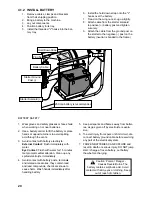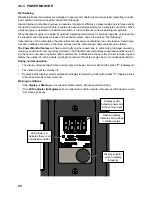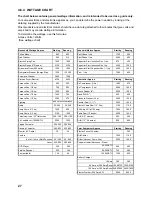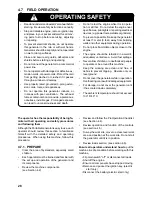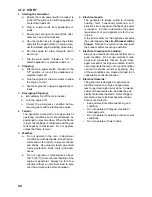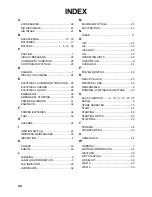
33
MAINTENANCE SAFETY
• Good maintenance is your responsibility.
Poor maintenance is an invitation to trouble.
• Read the instructions before you begin, and
make sure you have the tools and skills re-
quired. Do not smoke or have sources of ig-
nition nearby while performing maintenance.
• Follow good shop practices.
- Keep service area clean and dry.
- Be sure electrical outlets and tools are
properly grounded.
- Use adequate light for the job at hand.
• Make sure there is plenty of ventilation.
Never operate the engine in a closed build-
ing. The exhaust fumes may cause asphyxi-
ation.
• Before working on this machine, shut off the
engine, disconnect all loads, and turn fuel
valve off.
6 SERVICE AND MAINTENANCE
6.1 SERVICE
6.1.1 FLUIDS AND LUBRICANTS
1.
Engine Oil:
See engine owners manual for full detail on
oil type specific to operating conditions and
capacity.
2. Engine Fuel:
See engine owners manual for full detail on
fuel types and limitations.
Fuel Tank Capacity: 20 Liter, (5.3 US gal)
3. Storing Lubricants:
Your machine can operate at top efficiency
only if clean lubricants are used. Use clean
containers to handle all lubricants. Store
them in an area protected from dust, moisture
and other contaminants.
• Never work under equipment unless it is
blocked securely.
•
A fire extinguisher and first aid kit should
be kept readily accessible while performing
maintenance on this equipment.
• Periodically tighten all bolts, nuts and
screws and check that all electrical and fuel
connections are properly secured to ensure
unit is in a safe condition.
• When completing a maintenance or service
function, make sure all safety shields and
devices are installed before placing unit in
service.
• Caution: Burns from hot parts. Let the en-
gine, alternator and exhaust system cool be-
fore touching.
•
Use only a non-flammable solvent, not gaso
-
line, to clean parts.
6.1.2 FLUIDS AND LUBRICANTS
Use the Maintenance Checklist provided to keep a
record of all scheduled maintenance.
1. Use a hand-held grease gun for all greasing.
2.
Wipe grease fitting with a clean cloth before
greasing, to avoid injecting dirt and grit.
3.
Replace and repair broken fittings immedi
-
ately.
4.
If fittings will not take grease, remove and
clean thoroughly. Also clean lubricant pas-
sageway. Replace fittings if necessary.


